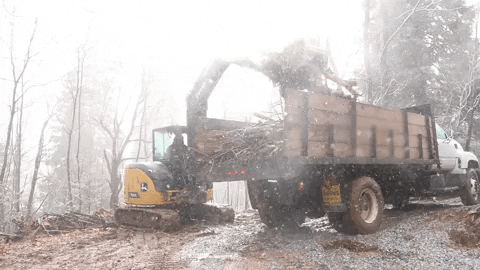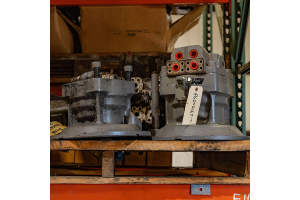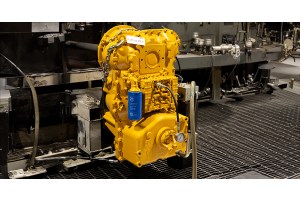
Winter is coming. You may like the cold, but your machines surely do not.
15 Winterization Tips
- Routine Inspections
- Changing to Winter Grade Fuel
- Inspect the Engine
- Change the Engine Oil
- Change Filters
- Battery Maintenance
- Adjust Coolant
- Check Hydraulics
- Check Hoses
- Inspect Tires
- Inspect Undercarriage
- Proper Storage
- Block Heaters
- Using Starter Fluid
- Store DEF Correctly
1. Routine Inspections
There are a few things that should be inspected and completed before and after any cold snaps, or after letting the machine sit for any extended period of time.
- Inspect each light
- Check windshield wipers
- Top off all fluid levels
- Insure functionality of the heater
- Lubricate engine components
- Inspect machine's body for unusual wear or dents/dings
- Check all glass and mirrors
- Test brake functionality
- Grease joins and hinges
2. Why change to Winter Grade Fuel?
There are two types of diesel fuel, aptly named Diesel #1 and Diesel #2. #1 is usually used for blending with #2, for colder temperatures. Diesel #2 gels. at colder temperatures. This can cause the fuel to become unusable, and a lot of headaches if it stops your engine. #1 is of a lower viscosity, and is usually more expensive, but most gas stations will offer a blend that is right for the area you're in.
3. Change the Engine Oil
- Oil flows much better in warmer weather, so it's easier to do before it gets too chilly.
- Multi-grade oil performs better in cooler temperatures.
4. Inspect the Engine
- Allow it to come up to operating temperature before using the machine. This eliminates exhaust and intake sticking.
- Low RPMs in the warm up stage make things easier on the intake and exhaust valves as well.
- Check the fan belts' condition, placement, and tension.
- Inspect the V-Pulley belts for proper functionality.
- Under or over tensioned belts are liable to completely slip off, or increase wear, respectively.
5. Changing the Filters
If and when you change fuel type, check your fuel filters to see if they need to be changed as well. Because clogged filters = an unhappy engine. It is also recommended to empty out the water trap before the first freeze of the season.
6. Battery Maintenance
Batteries are finicky components. They like to be stored in warm places, have full charges, and be free of dirt and debris.
- Try to store batteries somewhere indoors, at room temperature.
- At 32F, batteries lose around 65% of their cranking capacity.
- The lower the temperature, the lower the effectiveness of the battery, and the increased strain on the engine.
- Make sure to charge the battery in advance before using it in the cold, and recharge anytime it falls below 75% capacity.
- Remove debris and dirt from the battery if there is any.
- When storing a battery, be sure to store vertically, and DO NOT STACK THEM.
- If storing for longer than 10 days, remove the ground cables.
- If storing for the entire winter season, check on them every 4-6 weeks.
7. Check the Coolant
- Inspect for bubbles or other impurities.
- A good rule of thumb is for the coolant level to be about an inch above the core of the radiator.
- The lower the temperature, the lower the effectiveness of the battery, and the increased strain on the engine.
- Try to get coolant that will handle the expected temperatures of your location.
- Make sure to cut antifreeze properly, for sub-zero temperatures, a 50/50 cut with water is recommended. Less severe temps? More water is fine.
8. Check Hydraulics
- Replenish all hydraulic fluids.
- Lubricate the suction chamber and filter.
- Ensure the main hydraulic pump is in working order, and iis not leaking or running hot.
- Make sure to use hydraulic fluid that can handle cooler operating temperatures.
- Make sure all cylinders are greased up properly, not leaking, and functioning properly.
9. Check Hoses
- Check the condition of all hydraulic hoses to make sure that there are no cracks. If the wrapper on the hose swells, it is liable to crack.
- Make sure to get the engine to operating temperature before checking the hoses (carefully).
- To check hoses, squeeze them with your hand. Do they feel like rubber, or are they too brittle or too soft? Too soft often means the hose had contact with a lubricant, and are more likely to blow under high pressures. Too brittle means the hose was exposed to high heat, and has an increased chance of cracking.
10. Inspect Tires
- Tires have a harder time holding air in cooler temperatures.
- Inflate tires in warmer temperatures if possible, this also boosts the bead seal.
- Filling your machines' tires with nitrogen will help avoid ice crystal formation on the insides of your tires.
11. Inspect Undercarraige
- Any issues with undercarriage can be built upon by snow and ice, remedy them before the snow starts flying!
- Make sure rubber and steel tracks are not worn down to the point where they won't give you any traction on snow or ice.
- Was your machine buried under snow and ice? It's best to have a mechanic take a look at the moving parts in the undercarriage to be sure all is in working order.
12. Store the Machine Properly
- Storing in an enclosed facility is best.
- Storing fluids indoors at around room temperature will ensure no freezing and thawing of fluids you might need.
- Storing detachable parts separately from the machine helps avoid damage to joints and hinges, as well as helping combat rust.
13. Block Heaters
- Block heaters can help expedite the process of warming the engine and hydraulic fluids.
- Also eases tension on a chilly engine when coming to operating temperature.
14. Use Starting Fluid If Necessary
- Best to only use if necessary, as it is extremely flammable and can be dangerous.
- Because of the flammable nature, storing starter fluid in a safe space (not the machine's cab) is paramount.
15. Correct Storage of DEF
- Diesel Exhaust Fluid (DEF) requires careful storage as well, regardless of the grade.
- Even if it is formulated to be used at lower temperatures, that doesn't mean it is not going to freeze.
- As a rule of thumb, DEF tends to freeze below 12F.
- If your DEF freezes, thaw it carefully, as to not make it explode.









